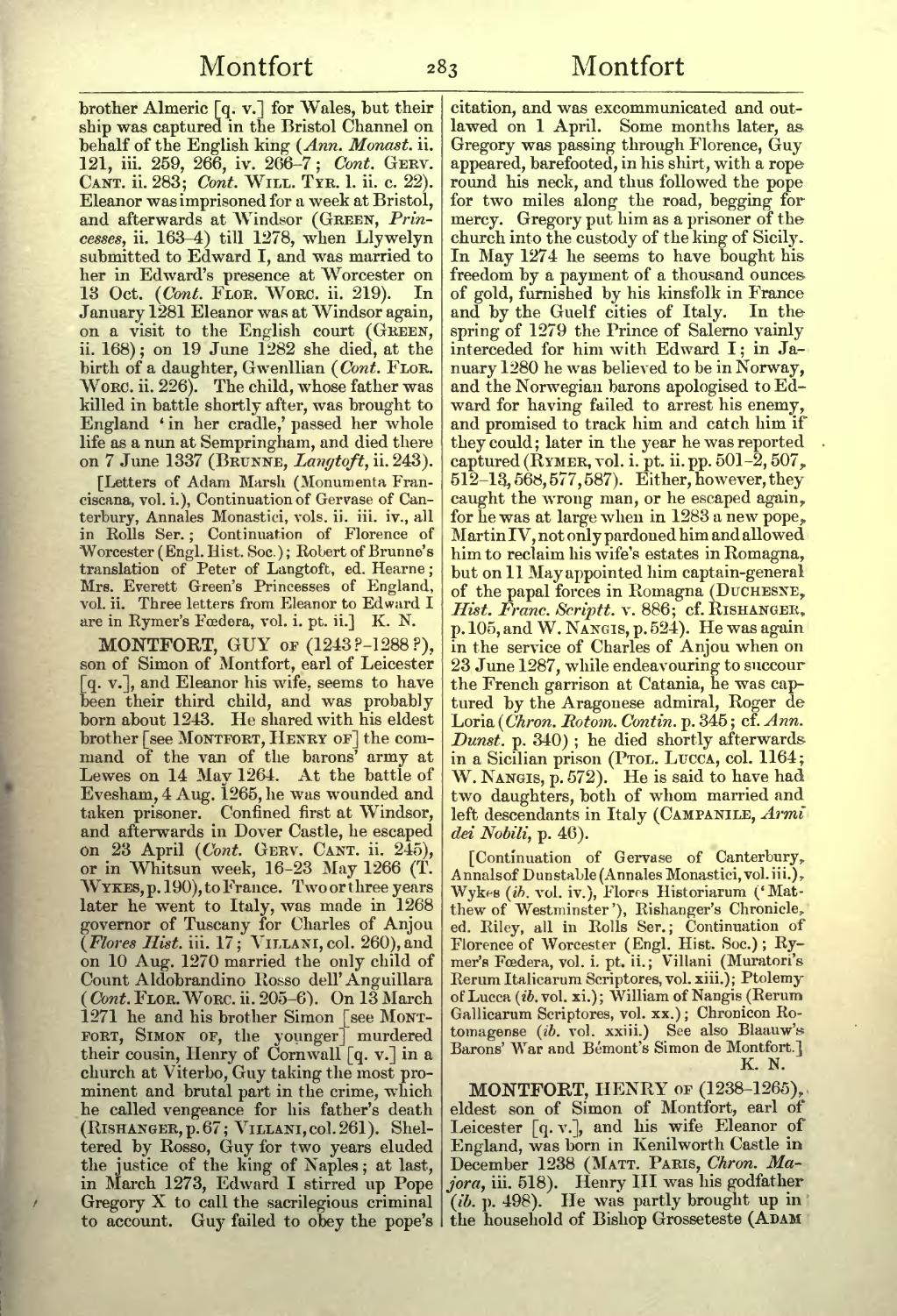brother Almeric [q. v.] for Wales, but their ship was captured in the Bristol Channel on behalf of the English king (Anne. Monast. ii. 121, iii. 259, 266, iv. 266-7; Cant. Gerv. Cant. ii. 283; Cont. Will. Tyr. 1. ii. c. 22). Eleanor was imprisoned for a week at Bristol, and afterwards at Windsor (Green, Princesses, ii. 163-4) till 1278, when Llywelyn submitted to Edward I, and was married to her in Edward's presence at Worcester on 13 Oct. (Cont. Flor. Worc. ii. 219). In January 1281 Eleanor was at Windsor again, on a visit to the English court (Green, ii. 168); on 19 June 1282 she died, at the birth of a daughter, Gwenllian (Cont. Flor. Worc. ii. 226). The child, whose father was killed in battle shortly after, was brought to England 'in her cradle,' passed her whole life as a nun at Sempringham, and died there on 7 June 1337 (Brunne, Langtoft, ii. 243).
[Letters of Adam Marsh (Monumenta Franciscana, vol. i.), Continuation of Gervase of Canterbury, Annales Monastici, vols. ii. iii. iv., all in Rolls Ser.; Continuation of Florence of Worcester (Engl. Hist. Soc.); Robert of Brunne's translation of Peter of Langtoft, ed. Hearne; Mrs. Everett Green's Princesses of England, vol. ii. Three letters from Eleanor to Edward I are in Rymer's Fœdera, vol. i. pt. ii.]
MONTFORT, GUY of (1243?–1288?), son of Simon of Montfort, earl of Leicester [q. v.], and Eleanor his Avife. seems to have been their third child, and was probably born about 1243. He shared with his eldest brother [see Montfort, Henry of] the command of the van of the barons' army at Lewes on 14 May 1264. At the battle of Evesham, 4 Aug. 1265, he was wounded and taken prisoner. Confined first at Windsor, and afterwards in Dover Castle, he escaped on 23 April (Cont. Gerv. Cant. ii. 245), or in Whitsun week, 16-23 May 1266 (T. Wykes, p. 190), to France. Two or three years later he went to Italy, was made in 1268 governor of Tuscany for Charles of Anjou (Flores Hist. iii. 17; Villani, col. 260), and on 10 Aug. 1270 married the only child of Count Aldobrandino Rosso dell' Anguillara (Cont. Flor. Worc. ii. 205-6). On 13 March 1271 he and his brother Simon [see Montfort, Simon of, the younger] murdered their cousin, Henry of Cornwall [q. v.] in a church at Viterbo, Guy taking the most prominent and brutal part in the crime, which he called vengeance for his father's death (Rishanger, p. 67; Villani, col. 261). Sheltered by Rosso, Guy for two years eluded the justice of the king of Naples; at last, in March 1273, Edward I stirred up Pope Gregory X to call the sacrilegious criminal to account. Guy failed to obey the pope's citation, and was excommunicated and outlawed on 1 April. Some months later, as Gregory was passing through Florence, Guy appeared, barefooted, in his shirt, with a rope round his neck, and thus followed the pope for two miles along the road, begging for mercy. Gregory put him as a prisoner of the church into the custody of the king of Sicily. In May 1274 he seems to have bought his freedom by a payment of a thousand ounces of gold, furnished by his kinsfolk in France and by the Guelf cities of Italy. In the spring of 1279 the Prince of Salerno vainly interceded for him with Edward I; in January 1280 he was believed to be in Norway, and the Norwegian barons apologised to Edward for having failed to arrest his enemy, and promised to track him and catch him if they could; later in the year he was reported captured (Rymer, vol. i. pt. ii. pp. 501-2, 507, 512-13, 568, 577, 587). Either, however, they caught the wrong man, or he escaped again, for he was at large when in 1283 a new pope Martin IV, not only pardoned him and allowed him to reclaim his wife's estates in Romagna, but on 11 May appointed him captain-general of the papal forces in Romagna (Duchesne, Hist. Franc. Scriptt. v. 886; cf. Rishanger, p. 105, and W. Nangis, p. 524). He was again in the service of Charles of Anjou when on 23 June 1287, while endeavouring to succour the French garrison at Catania, he was captured by the Aragonese admiral, Roger de Loria (Chron. Rotom. Contin. p. 345; cf. Ann. Dunst. p. 340); he died shortly afterwards in a Sicilian prison (Ptol. Lucca, col. 1164; W. Nangis, p. 572). He is said to have had two daughters, both of whom married and left descendants in Italy (Campanile, Armi dei Nobili, p. 46).
[Continuation of Gervase of Canterbury, Annals of Dunstable (Annales Monastici, vol. iii.) Wykes (ib. vol. iv.), Flores Historiarum ('Matthew of Westminster'), Rishanger's Chronicle, ed. Riley, all in Rolls Ser.; Continuation of Florence of Worcester (Engl. Hist. Soc.); Rymer's Fœdera, vol. i. pt. ii.; Villani (Muratori's Rerum Italicarum Scriptores, vol. xiii.); Ptolemy of Lucca (ib. vol. xi.); William of Nangis (Rerum Gallicarum Scriptores, vol. xx.); Chronicon Rotomagense (ib. vol. xxiii.) See also Blaauw's Barons' War and Bemont's Simon de Montfort.]
MONTFORT, HENRY of (1238–1265), eldest son of Simon of Montfort, earl of Leicester [q. v.], and his wife Eleanor of England, was born in Kenilworth Castle in December 1238 (Matt. Paris, Chron. Majora, iii. 518). Henry III was his godfather (ib. p. 498). He was partly brought up in the household of Bishop Grosseteste (Adam
